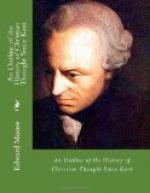It is not possible within the compass of this book to do more than deal with typical and representative persons. Schleiermacher was epoch-making. He gathered in himself the creative impulses of the preceding period. The characteristic theological tendencies of the two succeeding generations may be traced back to him. Many men worked in seriousness upon the theological problem. No one of them marks an era again until we come to Ritschl. The theologians of the interval between Schleiermacher and Ritschl have been divided into three groups. The first group is of distinctly philosophical tendency. The influence of Hegel was felt upon them all. To this group belong Schweitzer, Biedermann, Lipsius, and Pfleiderer. The influence of Hegel was greatest upon Biedermann, least upon Lipsius. An estimate of the influence of Schleiermacher would reverse that order. Especially did Lipsius seek to lay at the foundation of his work that exact psychological study of the phenomena of religion which Schleiermacher had declared requisite. It is possible that Lipsius will more nearly come to his own when the enthusiasm for Ritschl has waned. The second group of Schleiermacher’s followers took the direction opposite to that which we have named. They were the confessional theologians. Hoffmann shows himself learned, acute and full of power. One does not see, however, why his method should not prove anything which any confession ever claimed. He sets out from Schleiermacher’s declaration concerning the content of the Christian consciousness. In Hoffmann’s own devout consciousness there had been response, since his childhood, to every item which the creed alleged. Therefore these items must have objective truth. One is reminded of an English parallel in Newman’s Grammar of Assent. Yet another group, that of the so-called mediating theologians, contains some well-known names. Here belong Nitzsch, Rothe, Mueller, Dorner. The name had originally described the effort to find, in the Union, common ground between Lutherans and Reformed. In the fact that it made the creeds of little importance and fell back on Schleiermacher’s emphasis upon feeling, the movement came to have the character also of an attempt to find a middle way between confessionalists and rationalists. Its representatives had often the kind of breadth of sympathy which goes with lack of insight, rather than that breadth of sympathy which is due to the possession of insight. Yet Rothe rises to real distinction, especially in his forecast of the social interpretation of religion. With the men of this group arose a speculation concerning the person of Christ which for a time had some currency. It was called the theory of the kenosis. Jesus is spoken of in a famous passage of the letter to the Philippians; as having emptied himself of divine qualities that he might be found in fashion as a man. In this speculation the divine attributes were divided into two classes. Of the one class it was held Christ




